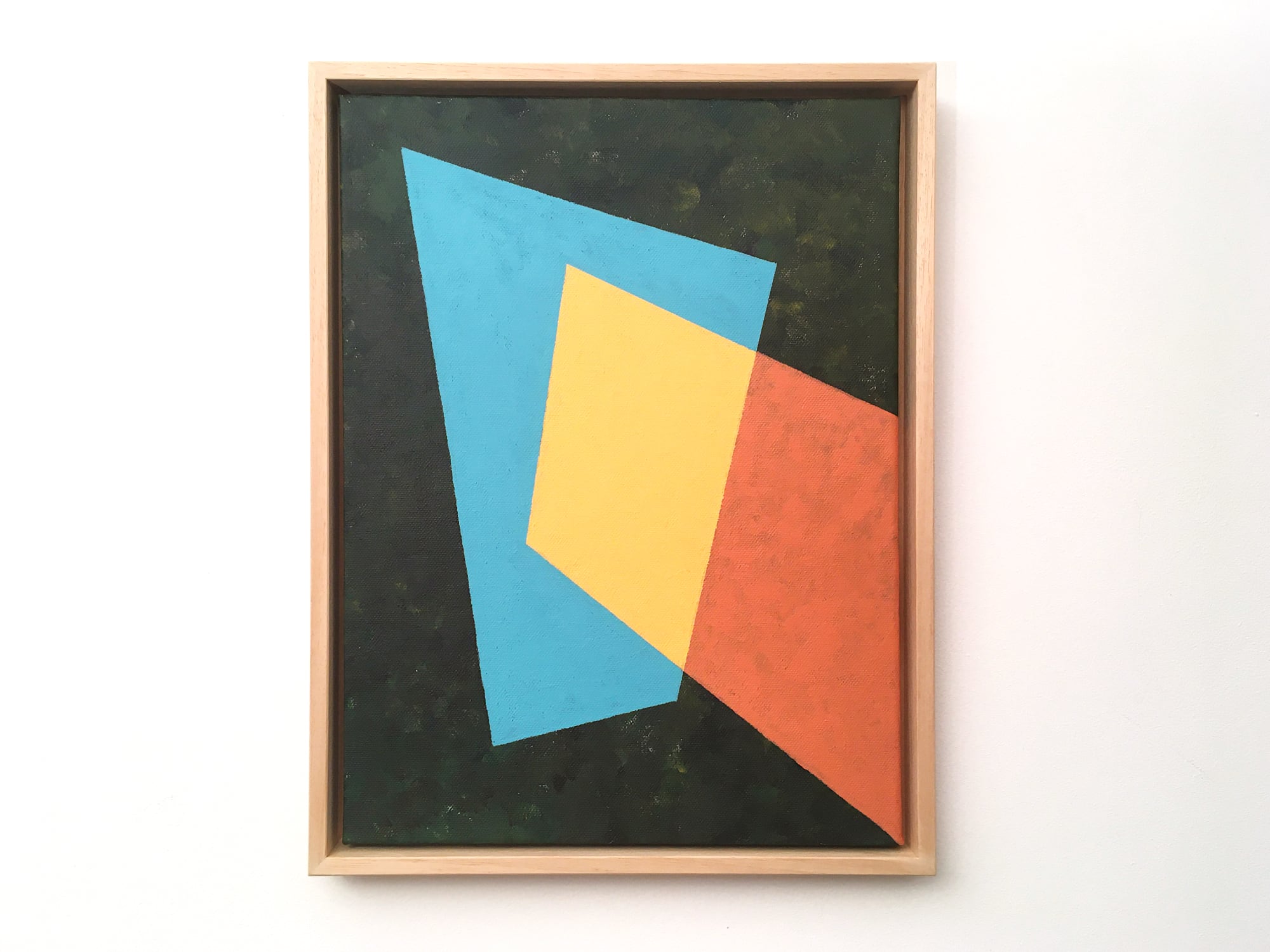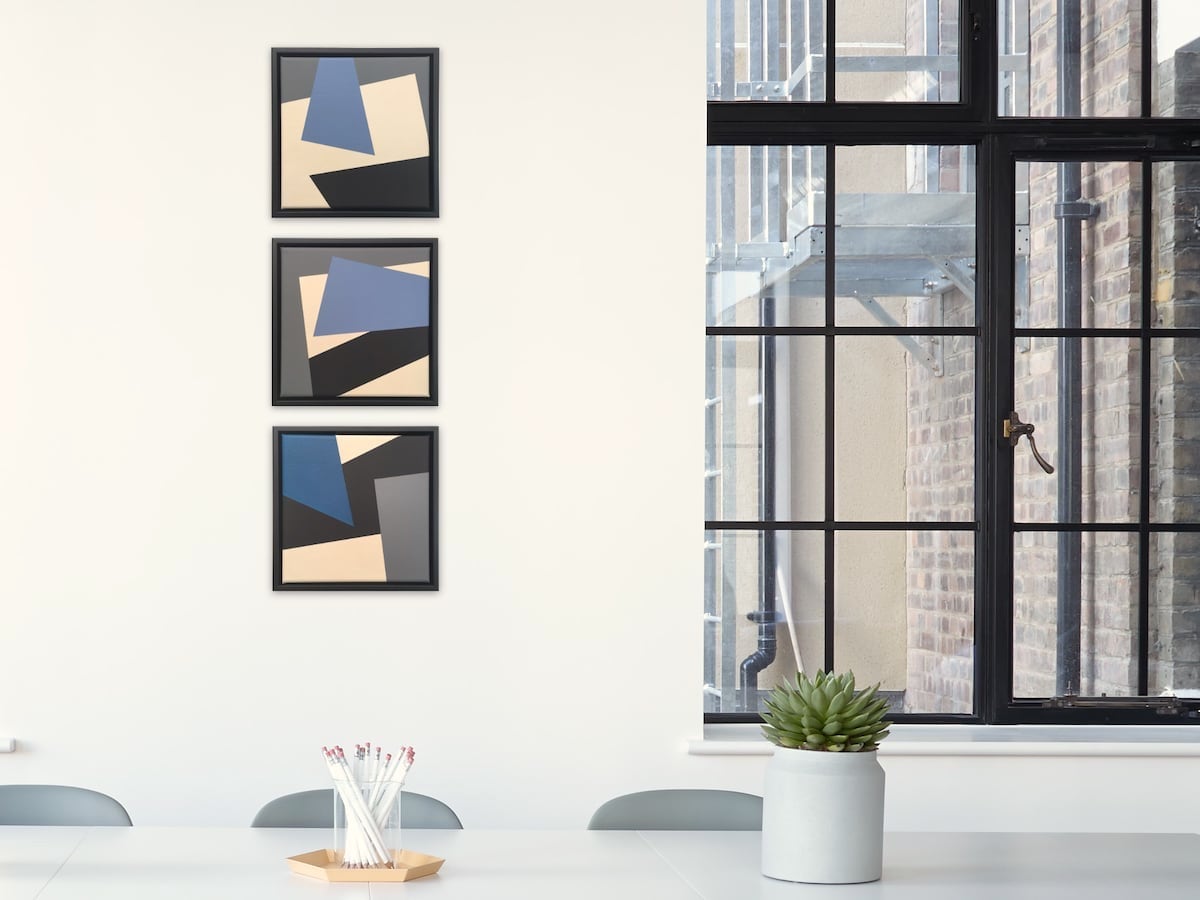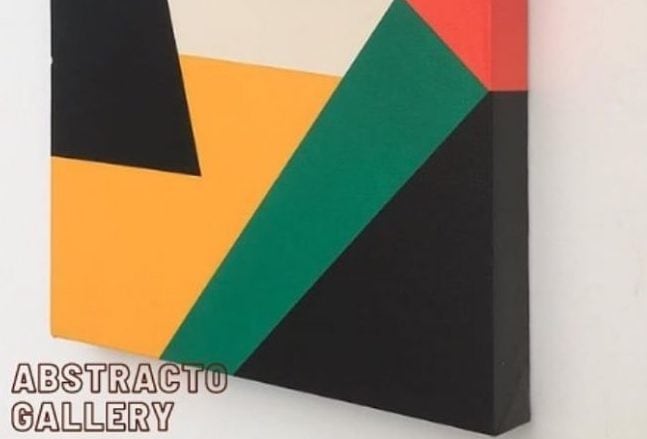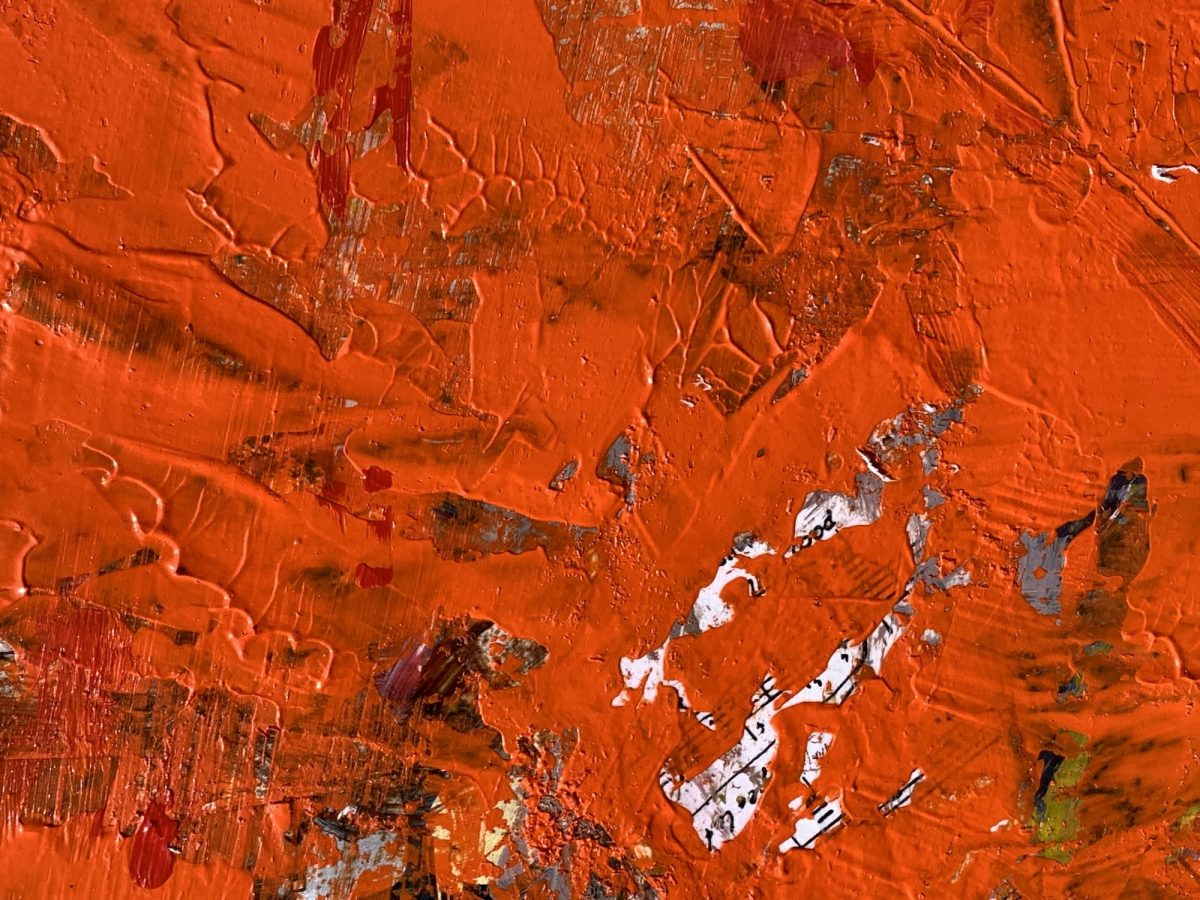Albert Compagner on impostor syndrome and being liberated by the abstract art
by Piotr Jastrzębski
Oct 24, 2020
At first, I associated Albert Compagner’s art mostly with hard-edge works. It occurred that for years he has been focused on design in the broadest sense of this word. He has done websites, e-books, illustrations, book covers, posters etc. Currently, Albert is fully focused on abstract paintings, which is giving him the most freedom.
I have also learnt that underneath his art, there is a deeper story. I didn’t expect that our interview will be so personal and at the end, it turns into material for contemplation.
Albert Compagner is an artist living and working in Valthermond, The Netherlands. You can find more about him on Instagram.
I have found you on LinkedIn and from what I understand, you were not a full-time painter for your whole professional life. What is your story?
After working at a publishing house for 15 years I had the opportunity to pursue, as they say, a new challenge. That was a couple of years ago. I didn’t know what I was going to do next, so I took some time to investigate what I enjoyed doing most. I remembered that when I finished high school I was actually thinking about going to art academy. But I was a very insecure boy and ‘sensible’ adults talked me out of it. Back then it was all about getting a ‘proper job’. But I did register to study Industrial Design at the Tech University in Delft, so I could combine creativity with my interest in engineering. Unfortunately only a limited number of students could enrol and I didn’t get in. Then I studied Architecture for half a year, had several jobs, studied Dutch Literature at Groningen University and after my graduation started working at a publishing house. This is where I spent the largest part of my working career.
In my spare time I was drawing, making illustrations, cartoons, posters, book covers, et cetera, and I did some paintings too. I also did the artwork for the band I was playing in with some of my fellow students. It was fun and so satisfying to create things I figured I wanted to do it everyday. But making a living creating art isn’t easy. I knew this beforehand, so my girlfriend and I came to an arrangement where she would work more hours while I would do the housekeeping, cooking, bringing the kids to school, et cetera. By doing most of the renovation projects on our house ourselves, and living more frugally, we try to make ends meet while I have time to work on my paintings in my little studio at home.
Are you able to imagine yourself in a different occupation, in an industry different than art?
I’m very happy with my decision to pursue an artistic career, and I wish that I had made it much earlier in my life. But I have no problem picturing myself doing something else. As long as I’m able to create things, and that doesn’t necessarily mean artworks. But more importantly, I have to enjoy the things I do. In the past I sometimes forgot about that

What do you consider as the biggest challenge on your artistic path?
Not to get discouraged and stick to my decision to be a visual artist. I’m full of doubt and tend to have negative thoughts when it comes to my artistic accomplishments. Is what I am doing going good enough to call myself an ‘artist’? That sort of thing. They’ve got a name for that: the ‘impostor syndrome’. You feel like you have no idea what you’re doing and whether it’s any good. I sometimes feel ‘unqualified’ to do this because I don’t have a formal art education. Rationally I know this is nonsense, but I cannot prevent those thoughts from popping up. So I just have to deal with it I guess, but try not to worry too much about it. Some tips I picked up along the way that I hope will help: be nice to yourself, celebrate little successes, try not to compare yourself to others and share your work but also your mistakes (well… check my Instagram page).
Among your hard-edge paintings, I have discovered ones that probably were inspired by Pollock. What do you find special about this artist and his creations?
I do a ‘drip painting’ once in a while. Mainly to have fun and loosen up. I like that it’s so very different from doing ‘hard-edge’ paintings. You may even say that ‘action painting’ is quite the opposite, with the wild gestures of the brush, flicking your wrist, slinging paint onto the canvas. And without knowing exactly what the end result is going to be.
When you make something like that, people will quickly associate it with Jackson Pollock. There’s no way around it. That’s interesting in itself: if you ‘drip’ paint you will automatically create a Pollock style painting. I met a painter who did a lot of drip paintings and persistently claimed he ‘just did his own thing’. But all I saw in his studio were those big Jackson Pollock drip paintings! If that’s what you want to do, that’s perfectly fine of course. But if you are convinced you’re doing ‘your own thing’ you’re just fooling yourself. On the other hand, I think it’s impossible to be 100% original and an artist shouldn’t feel pressured to be so. For me, reading Austin Kleon’s ‘Steal Like an Artist’ helped. He justly points out that trying to be completely original will hinder your creativity. You should realise all creative work builds on what came before. But you have to add your own thing. It can be very useful to copy existing artworks as a way of learning.
As part of the process of finding your own style. I’ve tried Pollock, Kandinsky, De Kooning, Mondriaan, Picasso and others. It’s very educational but, more importantly, it is so much fun! It can be more insightful to do a painting than to read a book on an artist. And along the way, some elements will stick and can reappear in your own work. To quote Bruce Lee: “Absorb what is useful, discard what is not and add what is specifically your own”. Although he was talking about martial arts, it nicely applies to the creative development of an artist as well.
You have done a lot of hard-edge paintings. In your opinion, what is so special about this type of artistic expression?
I liked the simplicity. The straight lines, the shapes and the limited colour palette I guess. When I started making this type of paintings I didn’t know it was called ‘hard-edge’. I knew works of Piet Mondriaan (later called himself Mondrian), Theo van Doesburg and Malevich among others. This was older stuff, you know. I wasn’t up to date with more recent developments in Modern Art. Later I found out about Ellsworth Kelly, Carmen Herrera, John McLaughlin and more contemporary artists. I think what appeals to me most is that you can achieve so much with so little. Simple shapes and just a few colours. With bold colours and sharp angles you can let it explode. With subdued colours and other shapes you can make something more subtle. But to be honest I really don’t think about it that much. When I think too much about painting, rationalise it or try to put it into words what I’m doing, I feel it gets in the way. It hinders the creation process. I just have to do it. “Just shut up and paint…”
However, you are also experimenting with other approaches. Where does it come from?
I like to experiment and try out new things, techniques and styles. To see what works and what doesn’t. And whether I can use it. Also, I feel I’m just a novice and still have a lot to learn. I see so much great art by other artists that makes me think ‘I want to be able to do that!’. There are a lot of styles that I like. But I cannot sit down and think up something new. I just have to go to work and hope I bump into something new I hadn’t thought of before.

When do you know your painting is finished?
It depends on the type of painting. There are some exceptions, but most hard-edge paintings I design beforehand. For me that works best. When I think a design is done, the only thing to do is to transfer it onto the canvas. But then you would probably ask: when do you know your design is finished? That’s an intuitive matter. I push shapes around, stretching or reducing them, changing their colour until I’m pleased with what I see (mostly on the computer). Now and then it’s obvious: this is it! But more often I am fiddling a lot and moving around triangles, rectangles and trapeziums for hours on end, until I’m satisfied.
With other types of paintings it’s even harder to determine whether it is finished or not. Even when I’ve made some sketches for it. I’ve ruined enough paintings because I didn’t stop in time. That’s part of the process I think. You have to make mistakes like that and start over again. I guess more experienced artists have a better sense of when to stop adding paint.
What interests you the most in abstract painting?
The freedom. In the past I didn’t consider painting something ‘non-figurative’. Or even something that was less realistic (like, say a cubist portrait). Sometimes it was a real struggle to get an image exactly the way I pictured it in my head. Probably because I just lacked the necessary skills, haha. But when I made my first abstract work, I found it very liberating. I also felt a bit silly, that I had never tried it before. But I sensed I was onto something. For myself I mean. I thought, this is what I would like to do everyday. An abstract painting doesn’t have to resemble anything. There are no rules, there is no right or wrong. It’s merely texture, colours and shapes. I don’t know, it just feels good doing this. At the moment I’m less interested in painting something realistic or figurative. I consider an abstract painting very personal. In a way you are painting yourself. I looked it up, there’s a quote by Oscar Wilde: “Every portrait that is painted with feeling is a portrait of the artist”. I think that applies to abstract paintings as well.
Have you ever approached an artwork that has changed your life or transformed you in some way?
Victory Boogie Woogie by Piet Mondrian. That really blew me away when I first saw it in real life in The Hague. This was in 2012. But I remember that in the eighties I didn’t appreciate Mondrian’s work at all. I associated it with merchandise I saw everywhere. With the black lines, the planes in primary colours and white, printed on pencil cases, cookie jars, oven mitts and what not. That really turned me off. But it changed when I saw his works in real life, at the Kröller Müller museum, the Stedelijk Museum and Rijksmuseum in Amsterdam. It’s probably also because I love textures. Up close you can see his brushstrokes and the cracks in the paint. And that the lines and planes aren’t as straight and slick as they appear from a distance or in print. I believe you have to experience Mondrian in real life to appreciate his work. And that especially applies to Victory Boogie Woogie, with the visible thickness of the paint, the different directions of the brushstrokes, the pieces of tape and paper, the craquelure. It’s so ‘alive’ and vibrant and layered. I truly love it. He was way ahead of his time and always did his own thing. I admire that.
Where are you looking for inspiration and what inspires you?
I try to view a lot of art. Visit museums whenever I can, browse Instagram, Pinterest, artists’ websites and museum websites. I read books on art (or rather, look at the pictures). Keeping my eyes open. And since inspiration can come from everywhere, I try to soak everything up with an open mind. Literature, movies, documentaries, tv shows, magazines, and whatnot. Old stuff, contemporary things. And it can be very inspiring to meet other artists as well, hearing what they are doing, how they think.

I couldn’t stop myself from asking this question. Have you done illustrations for the book about coffee: “The perfect Moka Espresso: The missing manual for the Brikka moka pot”?
Yes, I’ve done the illustrations for this book. It started with the e-book itself. It was a side project of a friend of mine who wanted to try and self-publish a book. Since I’ve worked at a publishing house I had experience on the subject of publishing. I also had some expertise on how to build an EPUB (e-book). I ended up formatting the e-book, making the illustrations, optimising images and designing the book covers for the Dutch and the English edition.
Illustrating and editing a book about coffee sounds like a great experience. Are you a coffee lover?
Yes, I love a good cappuccino, a ‘flat white’ or a double espresso! I don’t drink a lot of coffee, but when I do, it must be good. At home I approach making coffee a bit like a ritual where I take the time to grind the beans, prepare my little Italian espresso coffee pot and put it on the kitchen stove. And take the time to enjoy drinking it, of course.
Can you give some advice to any self-taught artist or designer?
In my head I hear echos of others suggesting things like ‘always be yourself’, ‘don’t be afraid to make mistakes’, ‘never use black straight out of the tube’ or whatever. It’s easy to repeat things one believes are true, but I doubt if it’s really useful in practice. Advice probably has to be a lot more specific to be useful. We all have different goals, backgrounds and experiences, so we all ‘need’ slightly different advice. If any.
I read somewhere that when people give advice, most of the time they are talking to their younger self. And in that respect I did give it some thought. When it concerns bigger things like career moves, I would have to say that the one that resonated with me is: “do not take any advice, not from anyone, not even me” (unfortunately I cannot remember who said this, haha). I find the paradox very funny. But what I think it means that there are no easy answers. You have to figure it all out for yourself.
For those who are thinking I’m being overly serious on the subject, some advice I try to live by (let’s call them ‘tips’): get up early, get to work, create the things you like yourself, don’t think too much about it, be nice to yourself and have fun.
What is your favourite colour?
I don’t favour or exclude any colour when painting is concerned. When I just started painting I realised I used quite a lot of vermillion. But I wouldn’t call that my favourite colour, but it just worked in those specific paintings. It pops, like cadmium yellow for example. But I wouldn’t put on a T-shirt of either colour. So it all depends on the context.
Apart from that, when I have to choose, one colour of itself, on its own, I would say green. I like many shades of green.



